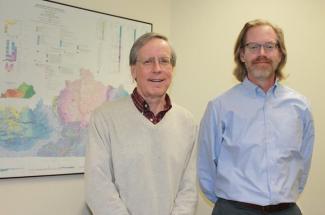KGS to Study Deep Unconventional Oil and Gas Potential With U.S. Department of Energy Grant

The Kentucky Geological Survey (KGS) at the University of Kentucky recently began work on a major research project to investigate the unconventional oil and gas potential of the Rogersville Shale formation in Eastern Kentucky and other related formations.
The multistage project, mostly funded by the U.S. Department of Energy with cost-share contributions from KGS and its partners, will have a total budget of $7,400,970 if all the stages are successfully completed. The Department of Energy share would be $5,876,897.
The project, referred to as the Conasauga Shale Research Consortium, will evaluate deeply buried but little explored shales within the Cambrian-age Conasauga Group — which includes the Rogersville Shale — that occur at depths of 8,000 to 10,000 feet within a geologic feature in Eastern Kentucky and West Virginia known as the Rome Trough. A Rogersville Shale discovery well was drilled in Lawrence County during 2013, but since then only five additional wells have been drilled into the formation. Although some oil and gas were encountered in the wells, the economic viability of the Rogersville Shale has yet to be established.
The project will also monitor groundwater and seismicity to help KGS researchers quantify and better understand the potential impacts of any future unconventional oil and gas development in the area. Project data and results will be released to the public in a final project report and will include a Rogersville Development Strategy Plan with suggested best practices for future Rogersville exploration and development.
“The potential impact of this project for the future oil and gas development of Conasauga Group shales is twofold," said John Hickman, principal investigator and UK research geologist. "First, the consortium website will be a ‘one-stop shop’ for all existing public data on the Conasauga Group (including any data produced by the project), expediting the initial stages of work at dramatically reduced costs, and future exploration teams. Second, the petroleum engineering data analytics of previous well completions will help direct future operations toward successful techniques and away from those less likely to be successful, enabling exploration teams to make better decisions by learning from others’ past failures."
Dave Harris, head of the KGS Energy and Minerals Section, scientists from the KGS Water Resources, Geologic Hazards, and Geoscience Information Sections, and the Earth Analysis and Research Library will be involved. The research builds on previous work by Hickman and Harris begun in 1998 as part of the Rome Trough Consortium, in which the hydrocarbon source-rock potential of Rogersville was first recognized.
The Conasauga Shale Research Consortium is being led by KGS and includes collaborators from West Virginia University and the West Virginia Geological and Economic Survey. The consortium will gather additional data and test multiple well-completion designs to determine if the Rogersville Shale and other Conasauga shales can be developed as unconventional oil and gas plays. All available preexisting data on the Conasauga, including data acquired under data-sharing agreements from all four operators of the six Rogersville Shale unconventional oil and gas wells, will be compiled. These data will be augmented with new samples and data collected during the drilling of a new horizontal well lateral into the Rogersville Shale in Lawrence County.
The study will evaluate the Rogersville and other shales using several methods, including determination of thermal maturity, organic and lithologic content, pore types, and traditional and noble gas geochemistry of oil or gas that is produced, programmed pyrolysis of source-rock samples, and lithologic and geomechanical analysis for developing effective completion strategies. The work will also produce detailed subsurface naps of the entire Conasauga Group.
These data will be compiled, shared and combined with extensive proprietary datasets acquired by West Virginia University for thousands of well-completion parameters and production data from at least three other unconventional oil and gas shale plays. Data analytics and machine-learning techniques will be used to identify suggested completion designs for attaining maximum efficiency and recovery from future Rogersville unconventional oil and gas wells.
Hay Exploration of Ashland, Kentucky, is the project’s co-funding industry partner. Cimarex Energy, Denver, Colorado; EQT Corp., Pittsburgh, Pennsylvania; Cabot Oil and Gas, Pittsburgh, Pennsylvania; Chesapeake Energy, Oklahoma City, Oklahoma; and Evans Geophysical, Suttons Bay, Michigan, are providing data for the project.
UK and the Kentucky Geological Survey appreciate the support of Senate Majority Leader Mitch McConnell and Rep. Hal Rogers, both of whom were instrumental in providing the critical funding to support the university’s work in unconventional oil and natural gas plays.





